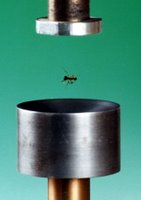





 Those of us who have been entrusted with a license to operate a motor vehicle on our nation's roadways know the freedom and independence that go along with that. But we also know - all too well - the accompanying frustration and danger: dodging idiots who think they own the road, dealing with frightened drivers who have no idea how to merge, getting stuck behind someone with the neurological disorder that makes them subtract 25 from every speed limit sign, or just having to sit in rush hour traffic without your iPod. (I'm still trying to figure out why it's called "rush hour," but that's another issue altogether.)
Those of us who have been entrusted with a license to operate a motor vehicle on our nation's roadways know the freedom and independence that go along with that. But we also know - all too well - the accompanying frustration and danger: dodging idiots who think they own the road, dealing with frightened drivers who have no idea how to merge, getting stuck behind someone with the neurological disorder that makes them subtract 25 from every speed limit sign, or just having to sit in rush hour traffic without your iPod. (I'm still trying to figure out why it's called "rush hour," but that's another issue altogether.) The champion of this "less is more" philosophy is a Dutch traffic engineer named Hans Monderman. Monderman designs intersections and town squares with no traffic signage whatsoever - no stop signs, no crosswalks, nothing. These places handle substantial daily traffic, yet with better accident rates than they had back when they were festooned with warnings. (Monderman has been known to demonstrate the safety of his designs by blithely stepping into traffic and walking across one of his highway intersections. Backwards.)
The champion of this "less is more" philosophy is a Dutch traffic engineer named Hans Monderman. Monderman designs intersections and town squares with no traffic signage whatsoever - no stop signs, no crosswalks, nothing. These places handle substantial daily traffic, yet with better accident rates than they had back when they were festooned with warnings. (Monderman has been known to demonstrate the safety of his designs by blithely stepping into traffic and walking across one of his highway intersections. Backwards.) Here in the United States we've yet to embrace the notion of ripping out our traffic signs, and Noyce doesn't see that happening anytime soon. He says our expectation of heavy signage is too ingrained.
Here in the United States we've yet to embrace the notion of ripping out our traffic signs, and Noyce doesn't see that happening anytime soon. He says our expectation of heavy signage is too ingrained.
 The idea will not surprise science fiction aficionados. It was widely explored by Dr Isaac Asimov, one of the foremost science fiction writers of the 20th century. He wrote of a society where robots were fully integrated and essential in day-to-day life.
The idea will not surprise science fiction aficionados. It was widely explored by Dr Isaac Asimov, one of the foremost science fiction writers of the 20th century. He wrote of a society where robots were fully integrated and essential in day-to-day life.
 But what I find most interesting of all is that while scientists admit there are things they just don't know, they will readily assert that there is no God - that the universe in which we live came about purely by chance. If anything, this list serves as an example of man's finite mind. The more we learn, the more we learn how much we really have yet to learn. And if we are pursuing knowledge for selfish reasons (i.e., for reasons other than glorifying the Creator of all things), then it is as King Solomon said: "I have seen everything that is done under the sun, and behold, all is vanity and a striving after wind. ... For in much wisdom is much vexation, and he who increases knowledge increases sorrow" (Ecclesiastes 1:14, 18).
But what I find most interesting of all is that while scientists admit there are things they just don't know, they will readily assert that there is no God - that the universe in which we live came about purely by chance. If anything, this list serves as an example of man's finite mind. The more we learn, the more we learn how much we really have yet to learn. And if we are pursuing knowledge for selfish reasons (i.e., for reasons other than glorifying the Creator of all things), then it is as King Solomon said: "I have seen everything that is done under the sun, and behold, all is vanity and a striving after wind. ... For in much wisdom is much vexation, and he who increases knowledge increases sorrow" (Ecclesiastes 1:14, 18).
 Hands-free surfing. The dream of every couch potato.
Hands-free surfing. The dream of every couch potato.
 There really isn't much in this world that bothers me, but I just won't tolerate a crappy cup of coffee. And very little else is more insulting than being offered coffee only to be handed a mug of brown-tinted water that tastes like it was filtered through a dirty sock.
There really isn't much in this world that bothers me, but I just won't tolerate a crappy cup of coffee. And very little else is more insulting than being offered coffee only to be handed a mug of brown-tinted water that tastes like it was filtered through a dirty sock.



Well, it's that time of year for the school Christmas pageant. At least, it is if your child is fortunate enough to attend a school that can call it a "Christmas" pageant. Our daughter Ellie sang with the third graders, while we hunched in the back bleachers taking distant fuzzy pictures, and thinking the same thing all the other parents were:
…………..“ELLIE! THAT WAS FANTASTIC! YOU SOUNDED BEAUTIFUL! I LIKE THE ONE YOU DID WITH THE HAND MOTIONS!”
 After the investigators got the ultrasound field going, they used tweezers to carefully place animals between the emitter and reflector. The scientists found they could float ants, beetles, spiders, ladybugs, bees, tadpoles and fish up to a little more than a third of an inch long in midair. When they levitated the fish and tadpole, the researchers added water to the ultrasound field every minute via syringe.
After the investigators got the ultrasound field going, they used tweezers to carefully place animals between the emitter and reflector. The scientists found they could float ants, beetles, spiders, ladybugs, bees, tadpoles and fish up to a little more than a third of an inch long in midair. When they levitated the fish and tadpole, the researchers added water to the ultrasound field every minute via syringe.